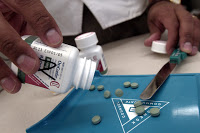Foundation funded by drug companies calls pill abuse overblown

 Almost 15,000 Americans die a year from prescription pain medication, a statistic that has the Centers for Disease Control and Prevention calling the problem “an epidemic.” But while the issue has been substantiated by troubling facts — in Kentucky, more people die from prescription drug overdoses than car accidents — the American Pain Foundation says it’s overblown. (Photo by Darren McCollester/Getty Images)
Almost 15,000 Americans die a year from prescription pain medication, a statistic that has the Centers for Disease Control and Prevention calling the problem “an epidemic.” But while the issue has been substantiated by troubling facts — in Kentucky, more people die from prescription drug overdoses than car accidents — the American Pain Foundation says it’s overblown. (Photo by Darren McCollester/Getty Images)
ProPublica found that “The foundation collected nearly 90 percent of its $5 million in funding last year from the drug and medical-device industry,” Charles Ornstein and Tracy Weber report for the nonprofit, independent investigative news service. “Some of the foundation’s board members have extensive financial ties to drug makers … and the group has lobbied against federal and state proposals to limited opioid use. Painkiller sales have increased fourfold since 1999, but the foundation argues that pain remains widely undertreated.”
The problem is not the drugs, but doctors who prescribe them too easily, contends Will Rowe, the foundation’s chief executive. “I’m convinced with every shred of my body that our interest is improving the lives of people affected by pain,” he said, “and we want to do that the best way we can.”
Last year, $8.5 billion in narcotic painkillers were sold in the United States, IMS Health found. The CDC reported enough drugs were prescribed last year to “medicate every American adult around the clock for a month.” OxyContin alone accounted for $3.1 billion in sales in 2010, up from $752 million in 2006. Last summer, the Institute of Medicine found 116 million American adults suffer from chronic pain.
The American Pain Foundation’s website lists several publications for patients, policymakers and journalists. “Each depicts the benefits of opioids, and each is underwritten by the makers of those drugs,” Ornstein and Weber report. Dr. Lewis Nelson, chairman of the federal Food and Drug Administration‘s Drug Safety and Risk Management Advisory Committee, said the funding behind these guides, by its very nature, slants them. “If you’re taking drug-company money and you’re working as an advocacy group for patients, I think by definition you’re biased,” he said. “I take everything they say with a grain of salt.” (Read more)